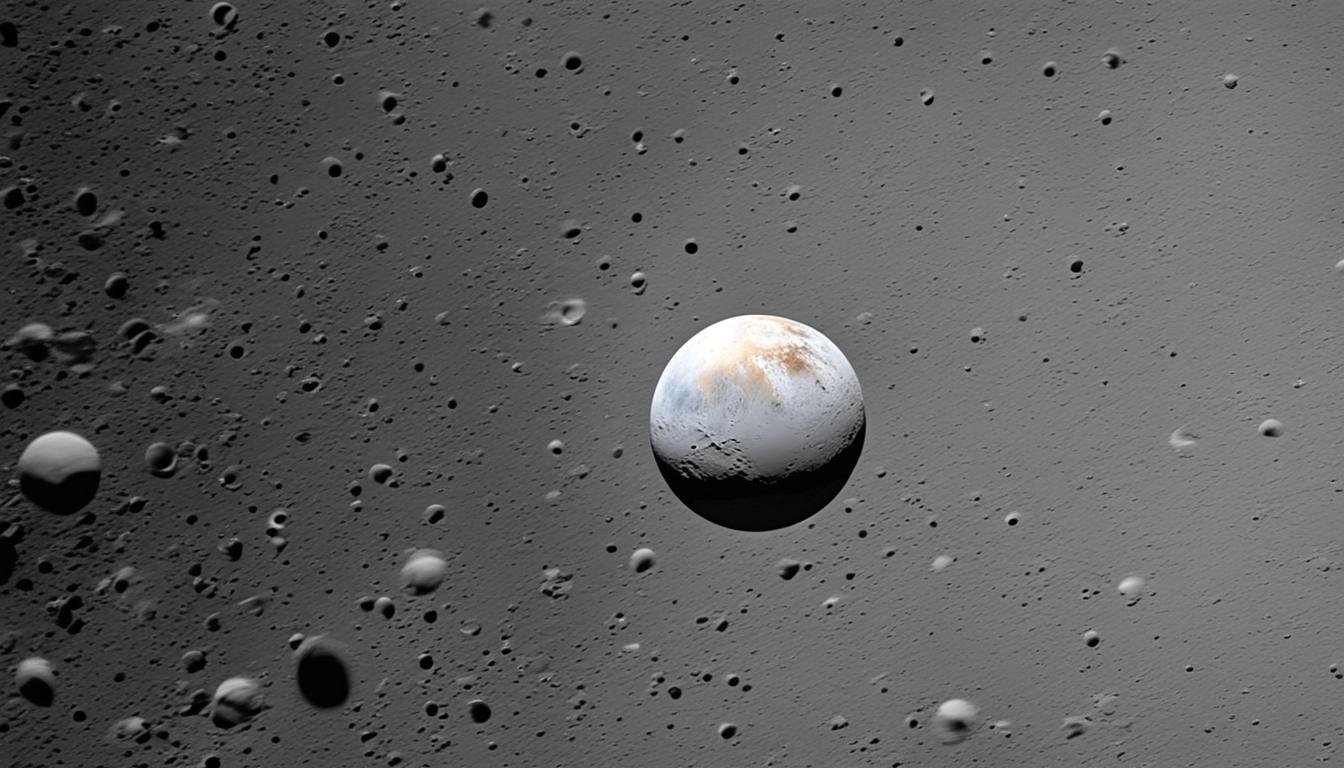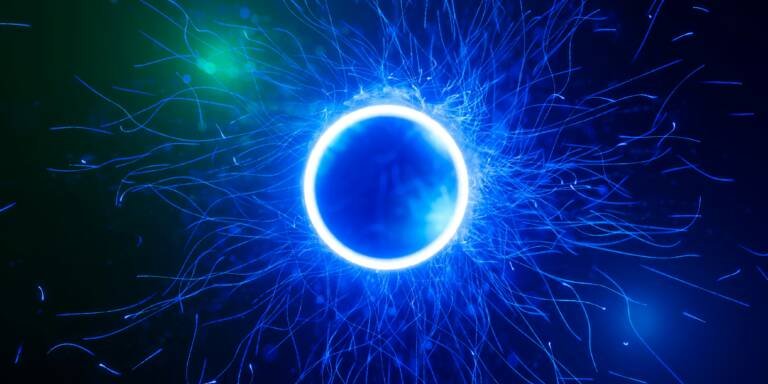Exploring Pluto: how many moons does pluto have?? I remember as a child, looking up at the night sky in wonder. I was amazed by the constellations and distant worlds. Now, we explore how many moons orbit Pluto. This distant world holds five moons—Charon, Styx, Nix, Kerberos, and Hydra. They circle Pluto in a cosmic dance12. Thanks to powerful telescopes and the New Horizons mission, we’ve discovered these moons. They show us Pluto is more than just a simple dwarf planet1.
The discovery of Pluto’s moons is like a message from the Kuiper Belt. It shows us the beauty of the cosmos. Charon is the biggest moon, about half of Pluto’s size. It shares a special dance with Pluto through space12. Nix, Hydra, Styx, and Kerberos have their own stories frozen in time. They make up Pluto’s family of moons, and they invite us to discover their secrets1. Let’s explore these shadows and ice to uncover what they hide.
The Discovery and Exploration of Pluto’s Moons
How many moons does pluto have?
When I first learned about the distant world of Pluto, I was filled with wonder. I asked, “Pluto moons how many?” It turns out, Pluto has five known moons13, with Charon being the largest3. Since Charon was first seen in 1978, our knowledge of these moons has grown. This has changed how we see our solar system and sparked curiosity about the pluto moons discovery.
The Historical Timeline of Pluto’s Satellite Discoveries
Clyde W. Tombaugh’s discovery of Pluto in 19303 marked the beginning. Then, James Christy spotted Charon in 1978, taking us closer to Pluto’s secrets. The Hubble Space Telescope played a key role, finding Nix and Hydra in 2005. This showed us Pluto had more than one moon.
The discovery of Kerberos in 2011 and Styx in 2012 added to our knowledge of the pluto and charon binary system3.
Understanding Pluto and Charon’s Unique Binary System
The relationship between Pluto and Charon is fascinating. Their gravity dance creates a barycenter about 960 km above Pluto’s surface1. This makes them a binary system, which is rare13. Their connection is more than math; it challenges how we think about far-off worlds.
I’ve put together a quick guide on Pluto’s moons. It includes sizes and how they move to satisfy your love for space:
| Moon Name | Longest Axis | Orbital Period Ratio (Styx:Nix:Hydra) | Obliquity | Shape |
|---|---|---|---|---|
| Charon | N/A | 1:1 with Pluto | Low | Collapsed Spheroid |
| Nix | ~42 km | 22 | High | Irregular |
| Hydra | ~55 km | 33 | High | Irregular |
| Styx | ~7 km | 18 | High | Irregular |
| Kerberos | ~12 km | Near Resonance with Charon | High | Irregular |
Looking closer at their paths shows they move together; round and flat, with slight tilts and orbits1. The New Horizons mission found something interesting. Nix, Hydra, Styx, and Kerberos tilt a lot. This might mean they had big collisions in the past1.
The question of “pluto moons how many” is more than just a number. It’s a clue to understanding a vast space music piece. Each moon adds to the pluto and charon system. Their dance, likely caused by a giant crash, shows the lively and connected nature of our universe.
Charon: Pluto’s Largest Moon and Its Unique Characteristics
In the cosmic arena, Charon is not just another name among Pluto’s moons. Found in 1978, this moon is notable both for its size and the special way it orbits with Pluto. They move together like dancers in space, only 19,640km apart. This makes Charon a key focus in understanding the relationship between Pluto and its moons4.
Charon is unique not just in its orbit. It shares its look with other moons like Styx, Nix, and Kerberos, but Hydra reflects light a bit more4. Charon’s makeup points to a rich mix of silicates and organic materials. This contrasts with the icy surface and hints at Charon’s varied geological past4.
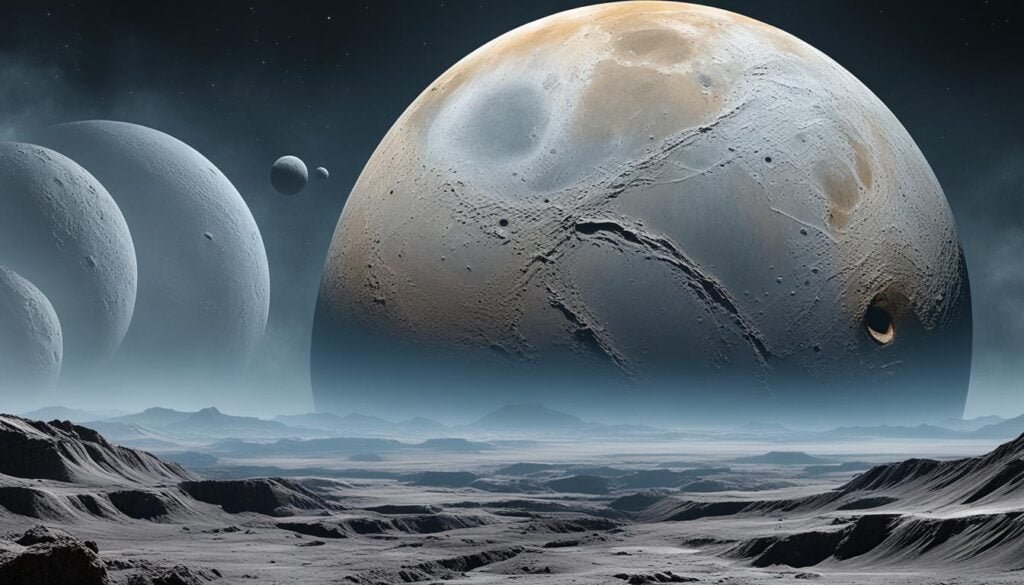
Charon stands out among Pluto’s moons with a radius of 604 km and a mass of 1.5 x 10^20 kg4. This table illustrates how Charon compares to Pluto’s other moons:
| Moon Name | Mean Radius | Orbital Period | Synchronous Rotation |
|---|---|---|---|
| Charon | 604 km | 6.387 Earth days | Yes |
| Styx | Data Unspecified | 20.2 days | No |
| Nix | Data Unspecified | 24.86 days | No |
| Kerberos | Data Unspecified | 32.1 days | No |
| Hydra | Data Unspecified | 38.2 days | No |
Charon’s table shows its unique orbit in stark contrast to the others4. These moons vary in their spinning speeds around Pluto. It hints that these moons may have come from a cloud of debris, merging over time. This hints at the complexity of how moons form around planets5.
Charon stands as Pluto’s key moon due to its size and how it moves with Pluto4. Yet, it is part of a fascinating group of moons. Each performs its own cosmic dance, showing the variety in our solar system5.
The Smaller Moons of Pluto: Nix and Hydra
I’m really into space and am always excited to learn about Pluto’s moons. Nix and Hydra, Pluto’s smaller moons, are super interesting. They’re not just numbers but mysterious worlds to discover. Let’s look into their discovery and details.
An Insight into the Discovery of Nix and Hydra
In 2005, astronomers found Nix and Hydra for the first time6. Imagine how thrilled they were to add these two moons to Pluto’s family. This discovery made us know more about space.
Physical Properties and Orbital Details of Pluto’s Small Moons
Studying these distant moons helps us understand more about space. Nix is 48,708 km away from Pluto and takes about 24.86 Earth days to orbit it4. Hydra is farther, at 64,749 km, and its orbit takes 38.2 days4. These small moons play a big part in studying the Kuiper Belt.
Nix is bright and reflects light, almost like white sand. Hydra’s orbit fits perfectly with Nix and Styx, making their movement together very precise6.
Let’s think of these moons as more than just data. They tell a story of how they came to be, through collisions and beauty. Below is a table of their orbital details:
| Moon | Mean Distance from Pluto (km) | Orbital Period (Earth days) |
|---|---|---|
| Nix | 48,708 | 24.86 |
| Hydra | 64,749 | 38.2 |
The moons’ lack of volatiles and grey colors suggest they came from one event5. Their similar makeup and how they orbit Pluto make them seem like siblings from an ancient collision5.
We’re waiting for more info from missions like New Horizons. I’m hopeful we’ll keep learning from these moons6.
Exploring space helps us see our place in the universe. Pluto is far, but its moons, like Nix and Hydra, guide our understanding of the solar system beyond.
Styx and Kerberos: The Latest Additions to Pluto’s Moon Family
The discovery of Pluto’s moons, Styx and Kerberos, is a big deal in astronomy. These new moons are hard to see, but they show how important it is to keep exploring and learning. Finding them proves we can always uncover new things in space.
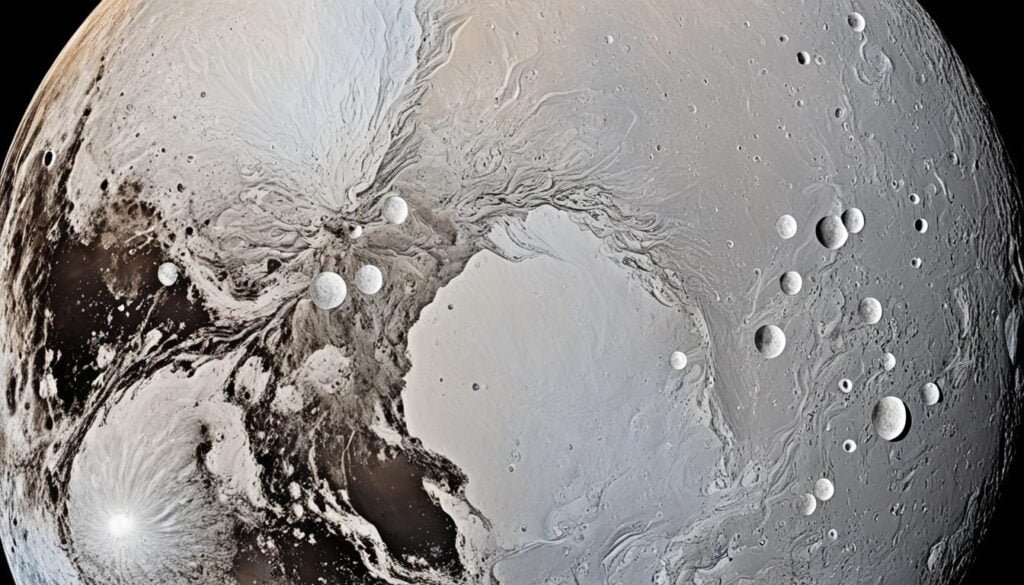
In 2011, we found Styx, and in 2012, we discovered Kerberos. These finds were thanks to the hard work of the Johns Hopkins University Applied Physics Laboratory and SwRI team. They lead the New Horizons mission. The team spotted these moons from over 55 million miles away, which is an amazing achievement.7
The Challenges and Achievements in Detecting Smaller Celestial Bodies
Finding Styx and Kerberos wasn’t easy. Styx is 20 to 30 times dimmer than Nix and Hydra. It’s only 4 to 13 miles across. Kerberos is a bit bigger, at 6 to 20 miles across. Despite their small size, these moons add to the diversity of Pluto’s family.7
The New Horizons mission has shown us wonders of Pluto we never knew existed. Flying close, just 6,500 miles away from Pluto, it lets us see the planet and its moons like never before. It makes us wonder what else is out there, waiting to be found8.
Learning that three of Pluto’s moons are linked by their gravity is fascinating. It shows how everything in space is connected. These discoveries about Pluto’s moons help us understand more about how celestial bodies interact with each other.8
| Moon | Discovery Year | Diameter Estimate (Miles) | Relative Brightness to Nix/Hydra |
|---|---|---|---|
| Styx | 2011 | 4-13 | 20-30 times fainter |
| Kerberos | 2012 | 6-20 | Not specified |
Our quest to understand Pluto’s moons is still going on. Every new image and data point gives us more clues. They help unravel Styx, Kerberos, and the vast mysteries of our solar system. This journey expands our view of the cosmos even more.
Understanding the Orbital Dance: Resonances and Alignments
The dance of orbiting moons around Pluto shows the lively universe we’re part of. Studying these moons as they move together is like watching a space ballet. Pluto and its moons are the main performers in this vast show.

Pluto’s moons include Charon, Styx, Nix, Kerberos, and Hydra9. They show us a special three-body resonance. In this pattern, Hydra orbits three times for every two orbits of Styx. It stays on a predictable path thanks to this arrangement9. This shows how well things can work together in space.
Charon is the biggest moon of Pluto, making up 11% of Pluto’s mass9. This large moon influences how the smaller moons move through space9. Together, they mimic larger cosmic structures in our galaxy.
Some moons, like Nix and Hydra, spin unpredictably9. This strange spinning gives us clues about the history of our solar system.
Current missions like New Horizons are studying Pluto’s moons9. They have confirmed there are no new moons beyond the five known ones. But, scientists think there could be more moons we haven’t found yet9.
New discoveries could change what we know about Pluto and its moons9. The universe is always surprising us with new information.
Pluto’s Moons and Their Chaotic Rotation Patterns
Looking closely at Pluto’s moons, we find their movement quirky and fascinating. Their chaotic rotation is unique in our solar system. These moons spin in ways that are hard to explain, all because of gravity’s complex effects6.
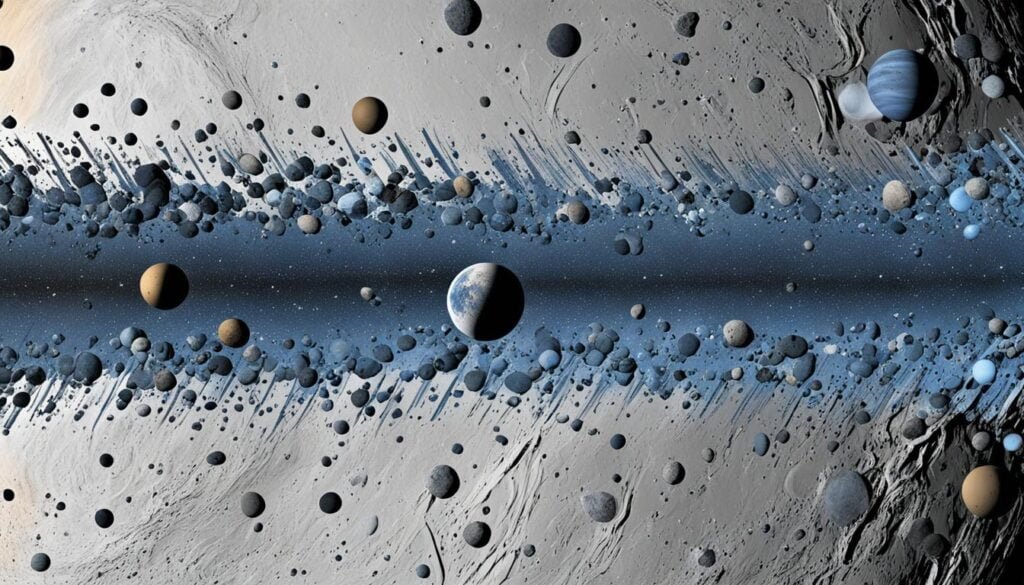
Tackling the Mysteries of Tumbling Moons in the Solar System
Pluto has five moons—Charon, Styx, Nix, Kerberos, and Hydra—with the last four spinning in wild ways. This odd spinning might be due to Pluto and Charon’s weird gravity6. Discovered between 2005 and 2012, these moons move chaotically in space6.
How New Horizons Mission Altered Our Understanding of Lunar Rotations
The New Horizons mission has been key to learning about these moon’s movements. This mission helps us learn a lot about Pluto, especially Kerberos and its dark look6. Thanks to New Horizons, we’re starting to get why these moons move in strange ways. It shows us that chaotic orbits might be normal around two-star systems, and hints at new theories for planets near such stars6.
When we look at Nix, Styx, and Hydra, we see a complex dance in their orbits. Even though Nix spins randomly, it keeps a steady path around Pluto. It shows us there’s a pattern in the chaos6.
The Formation of Pluto’s Moons: A Cosmic Collision Theory
The tale of Pluto’s moons’ formation ties directly to our solar system’s past. It’s about destruction and new beginnings, centered around a cosmic collision. This important event, akin to those that formed Earth’s Moon, left a mark on Pluto’s early history. From the resulting debris, Charon, Nix, Hydra, Styx, and Kerberos emerged as Pluto’s moons.
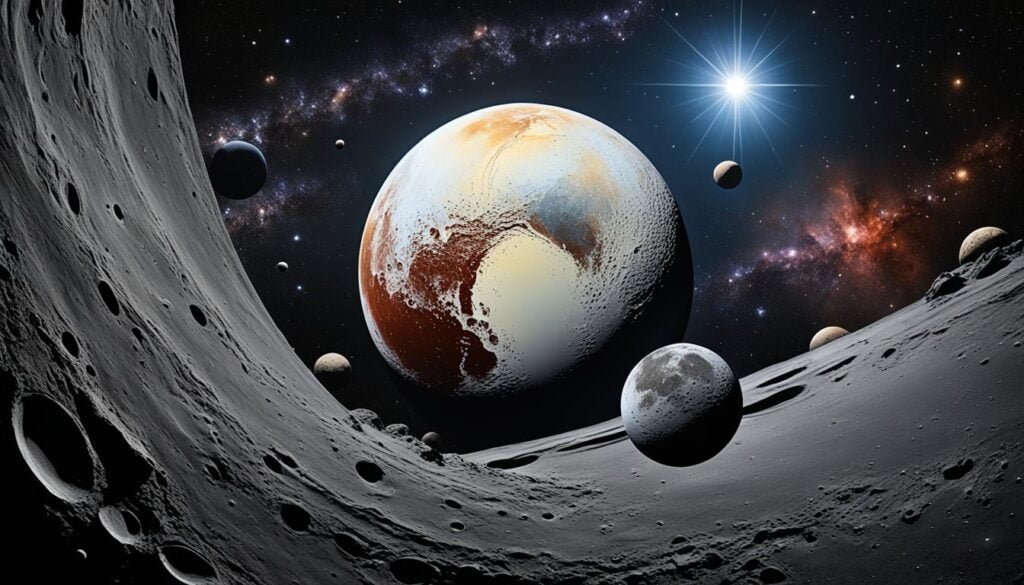
The New Horizons mission gave us a brief, yet deep, look at this far-off place. It showed us detailed images of Pluto’s sunlit side from 2 to 30 kilometers away1-k-k-k>. Before this, the Hubble Space Telescope could only give us much less clear pictures10
Scientific models now paint a picture of Pluto’s history. They say Sputnik Planitia’s creation likely stirred activity from a hidden ocean, with a mere 5% chance this was random1-k-k-k>. This eventful period may have also created chaotic landscapes on the far side. It suggests a huge underground ocean could exist, up to 150 kilometers deep10
Pluto’s surface shows signs of this hidden water. Pictures from New Horizons reveal many cracks, suggesting an ocean once flowed here before freezing over time. A massive crack going around the planet further supports this freezing process10
- Models hint at Pluto’s inner ocean being a likely scenario.
- There’s a chance for a vast ocean, 150 kilometers thick, under Pluto.
- Evidence suggests there was liquid water on Pluto that’s now mostly frozen.
These discoveries bring us closer to unraveling the mystery of Pluto’s moons’ formation. It’s a story filled with cosmic collisions and intrigues from the Kuiper Belt. The moons orbiting Pluto stand as quiet reminders of the dramatic events that shaped them and our solar system’s early days.
Comparing Size and Scale: Pluto Moons Size and the Solar System Context
When we explore the solar system scale, the size of Pluto’s moons shows big differences. Charon stands out as quite large compared to Pluto. This makes it unique in our solar system1112. Its size, with a radius of about 606 kilometers12, makes the other moons look tiny. This clearly shows how different Charon is from Pluto’s other moons.
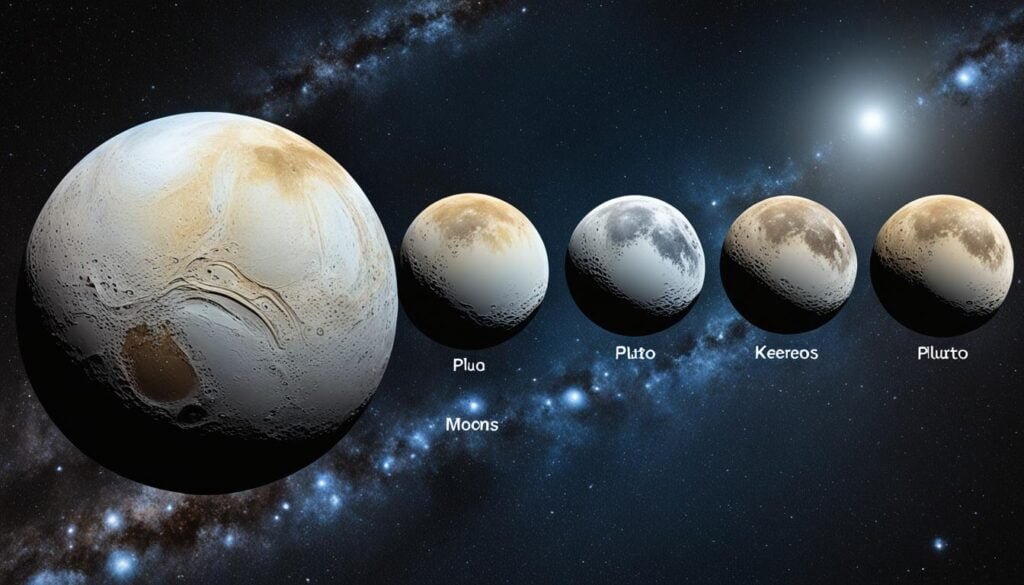
The smaller moons, Nix, Hydra, Styx, and Kerberos, seem tiny in space. Next to Charon, they look even smaller11. On Pluto, something that weighs 100 pounds on Earth would only be 7 pounds11. These moons move in the Kuiper Belt, filled with icy objects far from the Sun. This area is so distant that it’s a challenge for telescopes11.
Pluto is about 39.482 astronomical units from the sun12. This means it’s 5.9 billion kilometers away. From Pluto, sunlight is as bright as a full moon on Earth. Charon never moves from one side of Pluto, making for a constant sunset or sunrise11.
Comparing Pluto’s moons to other moons shows a big difference. Even our Moon is much bigger. Living on Pluto would be very cold, with temperatures around minus 400 degrees Fahrenheit11. This extreme temperature change from Earth to Pluto shows the various conditions in our solar system.
Charon may be the biggest of Pluto’s moons, but all of them moving together affects our solar system. Their movement shows the complex and beautiful nature of space. This intriguing dance of moons keeps us looking up and wondering about the universe.
Pluto’s Position in the Solar System: Moons, Orbit, and Influence
Exploring Pluto in the solar system reveals a fascinating count of 69 moons13. This number shows us the intricate nature of Pluto. The journey of discovery began in 1979 with Thebe and continues with the recent addition of moons S/2022 J1, J2, and J3 in 202213. Understanding Pluto’s orbit and its moons’ paths shows us the dwarf planet’s significant pull in the distant Kuiper Belt.
The history of finding Pluto’s moons is filled with adventure and progress13. S.S. Sheppard played a pivotal role, unearthing many moons that circle this frosty world13. The jump from 16 moons in 2003 to today’s number hints at Pluto’s large influence, beyond just gravity.
My research dives into the contrasting journeys of Pluto’s moons, like the long orbit of S/2000 J1 versus the quick loop of S/2021 J513. This exploration isn’t just about Pluto or its moons. It highlights the relentless human quest for knowledge and our universe’s vast mysteries.
Source Links
- https://en.wikipedia.org/wiki/Moons_of_Pluto
- https://www.nature.com/articles/nature.2015.17681
- https://en.wikipedia.org/wiki/Pluto
- https://www.britannica.com/place/Pluto-dwarf-planet/Plutos-moons
- https://www.forbes.com/sites/startswithabang/2017/07/19/did-a-big-whack-create-all-of-plutos-moons/
- https://phys.org/news/2015-06-unusual-interactions-pluto-moons.html
- https://www.nasa.gov/image-article/nasas-new-horizons-spots-plutos-faintest-known-moons/
- https://www.nationalgeographic.com/science/article/150603-pluto-moons-charon-styx-nix-kerberos-hydra-new-horizons
- https://www.scientificamerican.com/article/pluto-s-moons-move-in-synchrony/
- https://www.nature.com/immersive/d41586-020-02082-1/index.html
- https://spaceplace.nasa.gov/all-about-pluto/en/
- https://pluto.jhuapl.edu/Pluto/The-Pluto-System.php
- https://solarsystem.nasa.gov/moons/in-depth/
